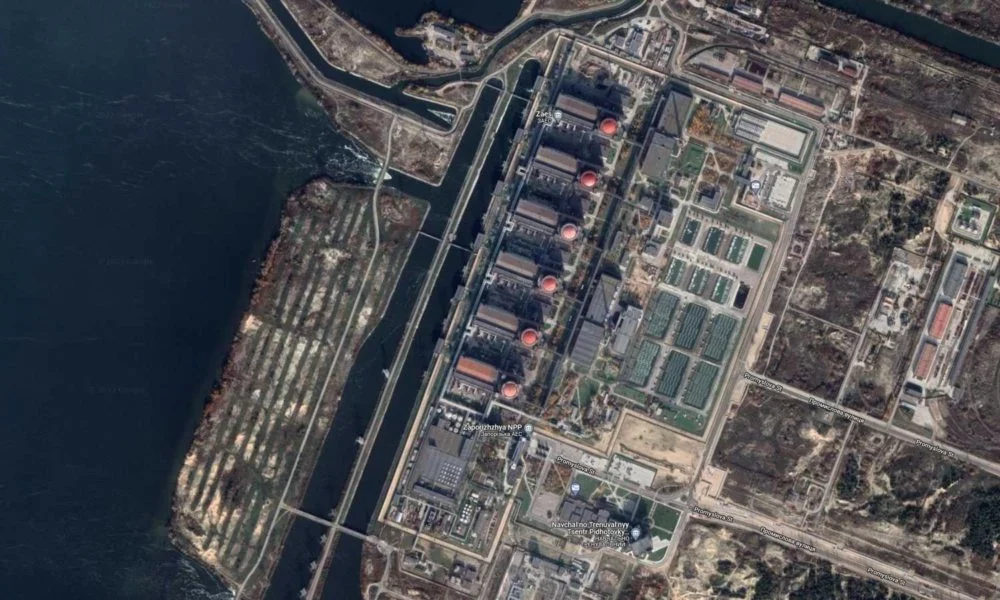Russian troops in Ukraine seized Europe’s biggest nuclear power plant Friday after shelling set part of the complex on fire, ringing alarm bells around the world of a potential nuclear disaster.
Ukrainian President Volodymyr Zelensky accused Russia of waging “nuclear terror” by attacking the plant deliberately and warned of the potential for another Chernobyl-like catastrophe, which took place in northern Ukraine in 1986 when the country was still part of the Soviet Union.
Plant personnel are operating the 5,700-megawatt, six-reactor Zaporizhzhia nuclear power plant under “gunpoint,” according to Ukrainian nuclear officials, and local authorities confirmed that the fire was extinguished around 6:20 a.m. local time (11:20 p.m. on the US East Coast) after burning for nearly five hours.
Fortunately, the fire was confined to a training facility and apparently did not damage the plant’s safety systems, and there was no release of radioactive material, according to the U.N. International Atomic Energy Agency (IAEA). However, the threat posed by Russia’s occupation of the plant, located about 342 miles southeast of Ukraine’s capital Kyiv, has not by any means dissipated.
The Zaporizhzhia plant is just one of four Ukrainian nuclear facilities whose 15 reactors provide more than half of the country’s electricity. None of the reactors were built to withstand a military assault. Although there is no way to know if Russia intentionally targeted Zaporizhzhia, all of the plants are also vulnerable to indirect fire that could damage critical support systems and surrounding infrastructure, potentially resulting in a fuel meltdown and a radiological release that could contaminate thousands of square miles of terrain.
As the situation on the ground unfolds, there are four major issues to keep in mind about the risks facing Ukraine’s nuclear sites in the midst of a war:
Nuclear fuel requires constant cooling
Water-cooled nuclear power plants such as the reactors at Zaporizhzhia utilize the intense heat produced by the fission of nuclear fuel to convert water into steam, which then spins turbines to generate electricity. Under normal operation, electrically powered cooling systems remove the heat by pumping water through the reactor core. If the cooling is interrupted, the fuel can heat up within a matter of hours to a temperature at which it can become damaged and begin to release highly radioactive fission products. If adequate cooling is not ultimately restored, the fuel can melt through the steel reactor vessel and—in the most severe situation—the containment structure can leak or rupture, releasing fission products to the environment.
This sequence of events occurred at three of the nuclear reactors at the Fukushima Daiichi plant in Japan in 2011. At Fukushima, an enormous earthquake disrupted the electrical grid that provided the power to run its cooling systems, and the tsunami that followed the earthquake flooded the site, disabling the emergency diesel generators and electrical distribution systems needed to provide backup power in the event that onsite power is lost. Despite the best efforts of plant personnel working under dire conditions and using whatever means were at hand, including car batteries and fire trucks, they were unable to restore sufficient cooling to prevent the three meltdowns. Hydrogen generated by the reaction of the fuel’s metal cladding with water accumulated to dangerous levels, resulting in hydrogen explosions that breached the confinements of two of the reactors and allowed more radioactive material to escape.
It’s important to note that even if a reactor is safely shut down and no longer generating electricity—which was the case at Fukushima—the fuel remains hot enough to damage itself if cooling is not sufficient. Nuclear reactors have pools on site to store used, or “spent,” nuclear fuel underwater, often in densely packed configurations. Like a reactor core, these pools require electrically powered cooling systems, although if cooling is lost there will typically be more time for plant operators to prevent fuel damage than with a reactor core. But for both reactors and spent fuel pools, reliable, long-term backup power is critical.
The Ukrainian plants’ spent fuel cooling pools are adjacent to the reactor vessel in the containment building, but they are smaller than pools at US plants.
Ukrainian plants are prepared for accidents, but not military attacks
There are a number of events that could trigger a worst-case scenario involving a reactor core or spent fuel pool located in a war zone: An accidental—or intentional—strike could directly damage one or more reactors. An upstream dam failure could flood a reactor downstream. A fire could disable plant electrical systems. Personnel under duress could make serious mistakes. The bottom line: Any extended loss of power that interrupted cooling system operations that personnel could not contain has the potential to cause a Fukushima-like disaster.
This danger is partly offset by the measures many countries required in the aftermath of Fukushima to strengthen the ability of nuclear plants to cope with accidents, known as station blackouts, involving long-term losses of both offsite power and onsite emergency diesel generators. Plant owners acquired additional equipment to provide emergency cooling, including portable diesel generators and diesel-powered fire pumps, and developed strategies to use them. However, these measures only work if the equipment is available and functional when needed, and plant personnel are capable of setting them up in time. Thus, this emergency equipment must survive whatever event disables installed (non-portable) plant equipment, and personnel must be able to get the equipment where it needs to go.
Nuclear plants have to ensure this post-Fukushima safety equipment can survive extreme weather events and earthquakes, but it is unlikely that they have “hardened” it enough to survive a major military assault. Each of the six reactors at Zaporizhzhia has three emergency diesel generators and there are two additional generators shared by Units 5 and 6. That configuration is more protective than the US requirement for only two emergency diesel generators per reactor unit. Ukraine requires nuclear plants to store sufficient fuel to operate the generators for seven days, the same as in the United States.
While redundant safety systems are necessary, they are not sufficient. There is always a risk of “common-mode” failures that affect all redundant equipment in the same way, so plants also need diverse backup systems. At Zaporizhzhia, there are additional options for restoring power, including connections to local hydroelectric plants and a thermal power plant. And if plant operators cannot restore power through normal means, then they would have to resort to using the 16 on-site mobile pumping units (fire engines) that the site obtained during its post-Fukushima upgrade. However, the likely availability and reliability of these units, especially under attack conditions, is unknown.
Plant operators’ health and safety is a major concern
Another issue that has become glaringly apparent is the fate of nuclear facility personnel when their workplace is seized by a hostile power. The takeover of the Chernobyl site on February 24 resulted in a situation where, as the Ukrainian government reported in a March 2 letter, Russian occupiers have kept plant operators at the site for a week without a new shift to relieve them, are subjecting them “to psychological pressure and moral exhaustion,” and giving them “limited opportunities to communicate, move, and carry out full-fledged maintenance and repair work.…” This dangerous situation raises the question of how shift turnover could be accomplished—that is, whether offsite personnel would be willing or able to report to work under such conditions. A prolonged inability to bring in fresh replacements would obviously impair the ability of the onsite staff to get enough rest to do their jobs effectively.
Although Chernobyl, which has no operating reactors, does have a spent nuclear fuel storage pool requiring attention, the problem of staff turnover will be more acute at operating nuclear plants such as Zaporizhzhia, which—given Ukraine’s reliance on nuclear power—likely cannot afford to be out of commission for more than a short time. And even if the country did shut them down, they would still require a significant complement of operations and maintenance personnel to manage the reactors and spent fuel storage facilities. Plant staff would experience fatigue on top of stress, which could lead to serious mistakes in running the reactors. If Russia takes over the plants, it may have no other choice but to bring in its own personnel to take over plant operation.
A Ukrainian meltdown would not be another Chernobyl
As Chernobyl so graphically demonstrated, a nuclear accident in Ukraine has the potential not only to contaminate Ukrainian territory, but also Belarus, Russia, and much of the rest of Europe. Although also Soviet-designed, the VVER-1000 light-water reactors in Ukraine, such as the six at Zaporizhzhia, are fundamentally different from the Chernobyl design. They are not as vulnerable to the particular sequence of events, including a massive steam explosion and long-duration fire, that made Chernobyl so severe and led to the wide dispersal of radioactivity over both Eastern and Western Europe, and even caused detectable levels in much of the Northern Hemisphere.
The consequences of a nuclear accident at one of the four operational Ukrainian nuclear plants could be similar to that of Fukushima, however. Multiple reactors could experience a loss of cooling and core damage without necessarily causing the major confinement breach that occurred at Chernobyl. The most significant land contamination from Fukushima extended at most some 25 miles from the site. Because of Fukushima’s location on the coast, however, 80 percent of the radioactive material the disaster released into the atmosphere is believed to have drifted over the ocean, which would not be the case at Ukraine’s land-locked plants. And even local contamination could greatly complicate the ability of Ukrainian authorities to care for both its civilian population and its troops.
After Fukushima, reactor owners worldwide also made plant modifications and developed plans to mitigate any radioactive releases that could occur after a core-melt accident. At Zaporizhzhia, operators installed systems in some of the reactors to neutralize hydrogen gas that could be released into the containment, but such systems generally cannot cope with high rates of hydrogen formation. Ukrainian authorities also determined that it would be appropriate for plants to install filtered vents to allow operators to reduce containment pressure without releasing large quantities of radioactive materials, but implementation has been slow. Other vulnerabilities, such as the potential for containment bypass in VVER-1000s in the event of a core melt accident, are even more difficult to address.
What can be done? From a safety perspective, the best-case scenario would be for Russia and Ukraine to establish “safe zones” around nuclear plants, modeled after the temporary “humanitarian corridors” that the two sides have agreed to create. In addition, Ukraine and Russia should negotiate an agreement to protect plant personnel and allow safe shift changes as well as emergency preparedness and response activities.
Let’s hope cooler heads prevail.
This post originally appeared on The Equation.

